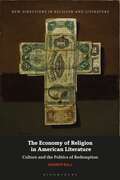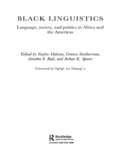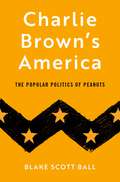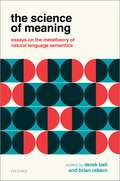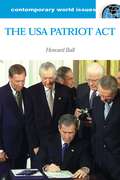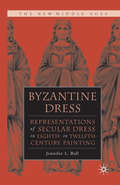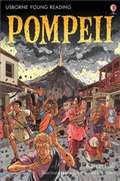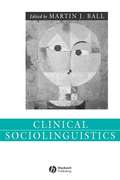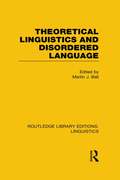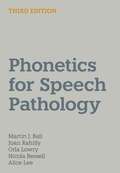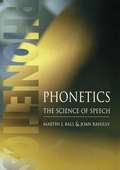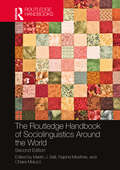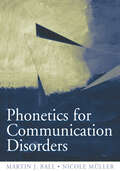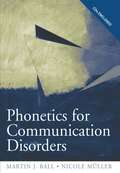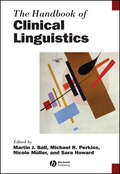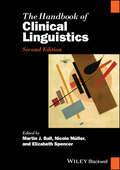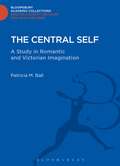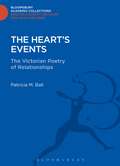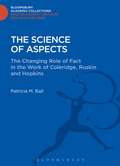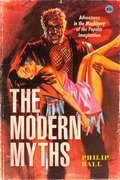- Table View
- List View
The Economy of Religion in American Literature: Culture and the Politics of Redemption (New Directions in Religion and Literature)
by Andrew BallOffering a thorough reassessment of modern American culture, this book examines how economic change influences religion, and the way literature mediates that influence. Focusing on the period 1840-1940, this book shows how the development of capitalism reshaped American Protestantism and addresses the necessary role of literature in that process. Arguing that the “spirit of capitalism” was not fostered by traditional Puritanism, but rather that Christianity was transformed by the Market and Industrial Revolutions, this book refutes the long-held secularization thesis by showing that modernity was a time when new forms of the sacred proliferated, and that this religious flourishing was essential to the production of American culture. It draws from the work of Émile Durkheim and cultural sociology to interpret modern social upheavals like religious awakenings, revivalism, and the labor movement. Examining work from writers like Rebecca Harding Davis, Jack London, and Countee Cullen, it shows how concepts of salvation fundamentally intersect with matters of race, gender, and class, and proposes a theory that explains the enchantment of modern American society.
Black Linguistics: Language, Society and Politics in Africa and the Americas
by Arnetha Ball Sinfree Makoni Geneva Smitherman Arthur K. Spears Forward by wa Thiong'oEnslavement, forced migration, war and colonization have led to the global dispersal of Black communities and to the fragmentation of common experiences.The majority of Black language researchers explore the social and linguistic phenomena of individual Black communities, without looking at Black experiences outside a given community. This groundbreaking collection re-orders the elitist and colonial elements of language studies by drawing together the multiple perspectives of Black language researchers. In doing so, the book recognises and formalises the existence of a "Black Linguistic Perspective" highlights the contributions of Black language researchers in the field.Written exclusively by Black scholars on behalf of, and in collaboration with local communities, the book looks at the commonalities and differences among Black speech communities in Africa and the Diaspora. Topics include:* the OJ Simpson trial* language issues in Southern Africa and Francophone West Africa* the language of Hip Hop* the language of the Rastafaria in JamaicaWith a foreword by Ngugi wa Thiong'o, this is essential reading for anyone with an interest in the linguistic implications of colonization.
Black Linguistics: Language, Society and Politics in Africa and the Americas
by Arnetha Ball Sinfree Makoni Geneva Smitherman Arthur K. Spears Forward by wa Thiong'oEnslavement, forced migration, war and colonization have led to the global dispersal of Black communities and to the fragmentation of common experiences.The majority of Black language researchers explore the social and linguistic phenomena of individual Black communities, without looking at Black experiences outside a given community. This groundbreaking collection re-orders the elitist and colonial elements of language studies by drawing together the multiple perspectives of Black language researchers. In doing so, the book recognises and formalises the existence of a "Black Linguistic Perspective" highlights the contributions of Black language researchers in the field.Written exclusively by Black scholars on behalf of, and in collaboration with local communities, the book looks at the commonalities and differences among Black speech communities in Africa and the Diaspora. Topics include:* the OJ Simpson trial* language issues in Southern Africa and Francophone West Africa* the language of Hip Hop* the language of the Rastafaria in JamaicaWith a foreword by Ngugi wa Thiong'o, this is essential reading for anyone with an interest in the linguistic implications of colonization.
Charlie Brown's America: The Popular Politics of Peanuts
by Blake Scott BallDespite--or because of--its huge popular culture status, Peanuts enabled cartoonist Charles Schulz to offer political commentary on the most controversial topics of postwar American culture through the voices of Charlie Brown, Snoopy, and the Peanuts gang. In postwar America, there was no newspaper comic strip more recognizable than Charles Schulz's Peanuts. It was everywhere, not just in thousands of daily newspapers. For nearly fifty years, Peanuts was a mainstay of American popular culture in television, movies, and merchandising, from the Macy's Thanksgiving Day Parade to the White House to the breakfast table. Most people have come to associate Peanuts with the innocence of childhood, not the social and political turmoil of the 1960s and 1970s. Some have even argued that Peanuts was so beloved because it was apolitical. The truth, as Blake Scott Ball shows, is that Peanuts was very political. Whether it was the battles over the Vietnam War, racial integration, feminism, or the future of a nuclear world, Peanuts was a daily conversation about very real hopes and fears and the political realities of the Cold War world. As thousands of fan letters, interviews, and behind-the-scenes documents reveal, Charles Schulz used his comic strip to project his ideas to a mass audience and comment on the rapidly changing politics of America. Charlie Brown's America covers all of these debates and much more in a historical journey through the tumultuous decades of the Cold War as seen through the eyes of Charlie Brown, Lucy, Linus, Peppermint Patty, Snoopy and the rest of the Peanuts gang.
Charlie Brown's America: The Popular Politics of Peanuts
by Blake Scott BallDespite--or because of--its huge popular culture status, Peanuts enabled cartoonist Charles Schulz to offer political commentary on the most controversial topics of postwar American culture through the voices of Charlie Brown, Snoopy, and the Peanuts gang. In postwar America, there was no newspaper comic strip more recognizable than Charles Schulz's Peanuts. It was everywhere, not just in thousands of daily newspapers. For nearly fifty years, Peanuts was a mainstay of American popular culture in television, movies, and merchandising, from the Macy's Thanksgiving Day Parade to the White House to the breakfast table. Most people have come to associate Peanuts with the innocence of childhood, not the social and political turmoil of the 1960s and 1970s. Some have even argued that Peanuts was so beloved because it was apolitical. The truth, as Blake Scott Ball shows, is that Peanuts was very political. Whether it was the battles over the Vietnam War, racial integration, feminism, or the future of a nuclear world, Peanuts was a daily conversation about very real hopes and fears and the political realities of the Cold War world. As thousands of fan letters, interviews, and behind-the-scenes documents reveal, Charles Schulz used his comic strip to project his ideas to a mass audience and comment on the rapidly changing politics of America. Charlie Brown's America covers all of these debates and much more in a historical journey through the tumultuous decades of the Cold War as seen through the eyes of Charlie Brown, Lucy, Linus, Peppermint Patty, Snoopy and the rest of the Peanuts gang.
The Science of Meaning: Essays on the Metatheory of Natural Language Semantics
by Derek Ball Brian RabernBy creating certain marks on paper, or by making certain sounds-breathing past a moving tongue-or by articulation of hands and bodies, language users can give expression to their mental lives. With language we command, assert, query, emote, insult, and inspire. Language has meaning. This fact can be quite mystifying, yet a science of linguistic meaning-semantics-has emerged at the intersection of a variety of disciplines: philosophy, linguistics, computer science, and psychology.
The USA Patriot Act: A Reference Handbook (Contemporary World Issues)
by Howard BallThe USA Patriot Act: A Reference Handbook is an in-depth examination of the difficult wartime task of balancing civil liberties against national security.Within weeks of the September 11 terrorist attacks, overwhelming majorities in both houses of Congress passed the USA Patriot Act. The act immediately aroused bitter controversy. Some claim it impermissibly infringes on constitutional rights; others argue it is a necessary tool to ensure the security of the American homeland.Distinguished scholar and prolific author Howard Ball provides the background necessary for a reasoned, historical examination of both positions. He details the threats to America in the last 60 years, emphasizing terrorist acts; examines the temporary surrender of civil rights during past American wars; and uses that history to analyze the USA Patriot Act, both as it exists and as arguments rage over whether to strengthen or weaken the law.
Byzantine Dress: Representations of Secular Dress (The New Middle Ages)
by J. BallIn Byzantium there were two overlapping systems of dress: a semiotic one whereby dress was a code for rank and wealth, and a fashion system where dress was based on the desire to look a certain way. This book explains secular dress from the eighth to the twelfth centuries through an examination of painted representations.
Usborne Young Reading, Series 3: Pompeii (PDF)
by Karen BallEach title in this series contains a vivid evocation of a major historical catastrophe, in an easy-to-follow manner. 'Pompeii' recounts the tragic story of the Italian city that came to a sudden end upon the furious eruption of the volcano Vesuvius.
Clinical Sociolinguistics (Language in Society #15)
by Martin J. BallClinical Sociolinguistics examines how sociolinguistic research paradigms can be applied to assessment, diagnosis and treatment in the clinical situation. fills gap in the literature for speech-language pathologists by addressing how sociolinguistic research paradigms can be applied to assessment, diagnosis and treatment in the clinical situation collects newly commissioned articles written by top scholars in the field includes chapters that outline findings from sociolinguistic research over the last 40 years and point to the relevance of such findings for practicing speech-language pathologists discusses topics including bilingualism, code-switching, language planning, and African-American English
Theoretical Linguistics and Disordered Language: Linguistics: Theoretical Linguistics And Disordered Language (Routledge Library Editions: Linguistics)
by Martin J. BallThe rapid increase of interest in disordered speech and language among linguists over the past decade or so has resulted in many books of practical help to speech pathologists in terms of assessment and remediation. Little, however, has appeared to examine the theoretical implications of the interaction between these two fields. This book aims to fill this gap, by showing how speech pathology can inform linguistic theory and vice versa.
Theoretical Linguistics and Disordered Language (Routledge Library Editions: Linguistics)
by Martin J. BallThe rapid increase of interest in disordered speech and language among linguists over the past decade or so has resulted in many books of practical help to speech pathologists in terms of assessment and remediation. Little, however, has appeared to examine the theoretical implications of the interaction between these two fields. This book aims to fill this gap, by showing how speech pathology can inform linguistic theory and vice versa.
Phonetics For Speech Pathology (Communication Disorders And Clinical Linguistics Ser.)
by Martin J. Ball Nicola Bessell Alice Lee Orla Lowry Joan RahillyThe new, third, edition of this indispensable guide for speech pathology and therapy students is completely updated, applying the results of the most recent research into speech disorders. Phonetics for Speech Pathology introduces normative aspects of phonetics and describes how these may go wrong in atypical speech, and the consequences when they do. The book deals with the three main areas of phonetics: articulatory, acoustic, and auditory, this last being often neglected in phonetics textbooks. The chapters are copiously illustrated, with most diagrams and figures newly drawn for this edition. Correct use of phonetic symbolizations and the importance of adequate transcription in the clinic are stressed, as is the use of instrumental analyses to augment impressionistic descriptions of speech. A range of modern instrumental techniques in speech analysis is covered, as are developments in hearing research including auditory processing disorder. The book concludes with an introduction to current models of speech production and perception.
Phonetics: The Science of Speech (Welsh Studies #Vol. 17)
by Martin J Ball Joan RahillyIn their comprehensive new introduction to phonetics, Ball and Rahilly offer a detailed explanation of the process of speech production, from the anatomical initiation of sounds and their modification in the larynx, through to the final articulation of vowels and consonants in the oral and nasal tracts. This textbook is one of the few to give a balanced account of segmental and suprasegmental aspects of speech, showing clearly that the communication chain is incomplete without accurate production of both individual speech sounds (segmental features) and aspects such as stress and intonation (suprasegmental features). Throughout the book the authors provide advice on transcription, primarily using the International Phonetic Alphabet (IPA). Students are expertly guided from basic attempts to record speech sounds on paper, to more refined accounts of phonetic detail in speech. The authors go on to explain acoustic phonetics in a manner accessible both to new students in phonetics, and to those who wish to advance their knowledge of key pursuits in the area, including the sound spectrograph. They describe how speech waves can be measured, as well as considering how they are heard and decoded by listeners, discussing both physiological and neurological aspects of hearing and examining the methods of psychoacoustic experimentation. A range of instrumentation for studying speech production is also presented. The next link is acoustic phonetics, the study of speech transmission. Here the authors introduce the basic concepts of sound acoustics and the instrumentation used to analyse the characteristics of speech waves. Finally, the chain is completed by examining auditory phonetics, and providing a fascinating psychoacoustic experimentation, used to determine what parts of the speech signal are most crucial for listener understanding. The book concludes with a comprehensive survey and description of modern phonetic instrumentation, from the sound spectrograph to magnetic resonance imaging (MRI).
Phonetics: The Science of Speech
by Martin J Ball Joan RahillyIn their comprehensive new introduction to phonetics, Ball and Rahilly offer a detailed explanation of the process of speech production, from the anatomical initiation of sounds and their modification in the larynx, through to the final articulation of vowels and consonants in the oral and nasal tracts. This textbook is one of the few to give a balanced account of segmental and suprasegmental aspects of speech, showing clearly that the communication chain is incomplete without accurate production of both individual speech sounds (segmental features) and aspects such as stress and intonation (suprasegmental features). Throughout the book the authors provide advice on transcription, primarily using the International Phonetic Alphabet (IPA). Students are expertly guided from basic attempts to record speech sounds on paper, to more refined accounts of phonetic detail in speech. The authors go on to explain acoustic phonetics in a manner accessible both to new students in phonetics, and to those who wish to advance their knowledge of key pursuits in the area, including the sound spectrograph. They describe how speech waves can be measured, as well as considering how they are heard and decoded by listeners, discussing both physiological and neurological aspects of hearing and examining the methods of psychoacoustic experimentation. A range of instrumentation for studying speech production is also presented. The next link is acoustic phonetics, the study of speech transmission. Here the authors introduce the basic concepts of sound acoustics and the instrumentation used to analyse the characteristics of speech waves. Finally, the chain is completed by examining auditory phonetics, and providing a fascinating psychoacoustic experimentation, used to determine what parts of the speech signal are most crucial for listener understanding. The book concludes with a comprehensive survey and description of modern phonetic instrumentation, from the sound spectrograph to magnetic resonance imaging (MRI).
The Routledge Handbook of Sociolinguistics Around the World
by Martin J. Ball Rajend Mesthrie Chiara MeluzziDrawing on examples from a wide range of languages and social settings, The Routledge Handbook of Sociolinguistics Around the World was originally the first single-volume collection surveying the current research trends in international sociolinguistics.This new edition has been comprehensively updated and significantly expanded, and now includes more than 50 chapters written by leading authorities and a brand-new substantial introduction by John Edwards. Coverage has been expanded regionally and there is a critical focus on Indigenous languages. This handbook remains a key tool to help widen the perspective on sociolinguistics to readers interested in the field. Divided into sections covering the Americas, Asia, Australasia, Africa, and Europe, the book provides readers with a solid, up-to-date appreciation of the interdisciplinary nature of the field of sociolinguistics in each area. It clearly explains the patterns and systematicity that underlie language variation in use, along with the ways in which alternations between different language varieties mark personal style, social power, and national identity.The Routledge Handbook of Sociolinguistics Around the World is the ideal resource for all students in undergraduate sociolinguistics courses and for researchers involved in the study of language, society, and power.
Phonetics for Communication Disorders
by Martin J. Ball Nicole MullerThis comprehensive textbook offers a basic introduction to phonetics in an applied systematic presentation that equips the communication disorders student to deal with the wide range of speech types that will be encountered in a clinic. While the major discussion is articulatory, speech acoustics are also examined. Illustrations of sample spectrograms appear in tandem with the more traditional articulatory drawings. Two CDs of sound examples accompany the textbook. This comprehensive textbook offers a basic introduction to phonetics in an applied systematic presentation that equips the communication disorders student to deal with the wide range of speech types that will be encountered in a clinic. While the major discussion is articulatory, speech acoustics
Phonetics for Communication Disorders
by Martin J. Ball Nicole MullerThis comprehensive textbook offers a basic introduction to phonetics in an applied systematic presentation that equips the communication disorders student to deal with the wide range of speech types that will be encountered in a clinic. While the major discussion is articulatory, speech acoustics are also examined. Illustrations of sample spectrograms appear in tandem with the more traditional articulatory drawings. Two CDs of sound examples accompany the textbook. This comprehensive textbook offers a basic introduction to phonetics in an applied systematic presentation that equips the communication disorders student to deal with the wide range of speech types that will be encountered in a clinic. While the major discussion is articulatory, speech acoustics
The Handbook of Clinical Linguistics (Blackwell Handbooks in Linguistics #56)
by Martin J. Ball Nicole Müller Michael R. Perkins Sara HowardThe Handbook of Clinical Linguistics brings together an international team of contributors to create an original, in-depth survey of the field for students and practitioners of speech-language pathology, linguistics, psychology, and education. Explores the field of clinical linguistics: the application of the principles and methods of linguistics to the study of language disability in all its forms Fills a gap in the existing literature, creating the first non-encyclopedic volume to explore this ever-expanding area of linguistic concern and research Includes a range of pathologies, with each section exploring multilingual and cross-linguistics aspects of the field, as well as analytical methods and assessment Describes how mainstream theories and descriptions of language have been influenced by clinical research
The Handbook of Clinical Linguistics (Blackwell Handbooks in Linguistics)
by Martin Ball Nicole Müller Elizabeth SpencerThe new edition of the leading reference work on Clinical Linguistics, fully updated with new research and developments in the field The Handbook of Clinical Linguistics, Second Edition provides a timely and authoritative survey of this interdisciplinary field, exploring the application of linguistic theory and method to the study of speech and language disorders. Containing 42 in-depth chapters by an international panel of established and rising scholars, this classic volume addresses a wide range of pathologies while offering valuable insights into key theory and research, multilingual and cross-linguistics factors, analysis and assessment methods, and more. Now in its second edition, The Handbook of Clinical Linguistics features nine entirely new chapters on clinical corpus linguistics, multimodal analysis, cognition and language, the linguistics of sign languages, clinical phonotactics, typical and nontypical phonological development, clinical phonology and phonological assessment, and two chapters on instrumental analysis of voice and speech production. Revised and expanded chapters incorporate new research in clinical linguistics and place greater emphasis on specific speech disorders, connections to literacy, and multilingualism. This invaluable reference works: Reflects the latest developments in new research and data, as well as changing perspectives about the priorities and future of the field Features new and revised chapters throughout, many with new authors or authorial teams Offers well-rounded coverage of the major areas of the speech sciences in the study of communication disorders Discusses how mainstream theories and descriptions of language are influenced by clinical researchBuilding on the success of the first edition, The Handbook of Clinical Linguistics, Second Edition, is an indispensable resource for researchers and advanced students across all areas of speech-language sciences, including speech disorders, speech pathology, speech therapy, communication disorders, cognitive linguistics, and neurolinguistics.
The Handbook of Clinical Linguistics (Blackwell Handbooks in Linguistics)
by Martin Ball Nicole Müller Liz SpencerThe new edition of the leading reference work on Clinical Linguistics, fully updated with new research and developments in the field The Handbook of Clinical Linguistics, Second Edition provides a timely and authoritative survey of this interdisciplinary field, exploring the application of linguistic theory and method to the study of speech and language disorders. Containing 42 in-depth chapters by an international panel of established and rising scholars, this classic volume addresses a wide range of pathologies while offering valuable insights into key theory and research, multilingual and cross-linguistics factors, analysis and assessment methods, and more. Now in its second edition, The Handbook of Clinical Linguistics features nine entirely new chapters on clinical corpus linguistics, multimodal analysis, cognition and language, the linguistics of sign languages, clinical phonotactics, typical and nontypical phonological development, clinical phonology and phonological assessment, and two chapters on instrumental analysis of voice and speech production. Revised and expanded chapters incorporate new research in clinical linguistics and place greater emphasis on specific speech disorders, connections to literacy, and multilingualism. This invaluable reference works: Reflects the latest developments in new research and data, as well as changing perspectives about the priorities and future of the field Features new and revised chapters throughout, many with new authors or authorial teams Offers well-rounded coverage of the major areas of the speech sciences in the study of communication disorders Discusses how mainstream theories and descriptions of language are influenced by clinical researchBuilding on the success of the first edition, The Handbook of Clinical Linguistics, Second Edition, is an indispensable resource for researchers and advanced students across all areas of speech-language sciences, including speech disorders, speech pathology, speech therapy, communication disorders, cognitive linguistics, and neurolinguistics.
The Central Self: A Study in Romantic and Victorian Imagination (Bloomsbury Academic Collections: English Literary Criticism)
by Patricia M. BallIn this closely argued book Dr Ball is concerned to analyse the imaginative process of self-understanding which emerged as a characteristic feature of English Romantic poetry and, acquiring fresh creative force in the Victorian period, has been transmitted to our own times as a determining principle of the contemporary imagination. Dr Ball relates her discussion to the distinction between the poet speaking directly in his own voice and the impulse to dramatised utterance – the two modes of poetic expression conveniently summed up in Keats's contrasting terms 'egotistical sublime' and 'chameleon'. She shows how these 'polar' tendencies co-exist fruitfully in the work of Wordsworth, Coleridge, Byron, Shelley and Keats and from this standpoint supplies a coherent appreciation of the little-regarded plays written by these poets. Turning to Victorian critics and poets Dr Ball considers how the Romantic inheritance fared at their hands. She sees in the poets, notably Tennyson, Arnold, Browning, and Hopkins, a vital link by which the Romantic commitment to the agency of self-consciousness has been carried forward to the twentieth century and concludes with a brief sketch of the creative role of self-exploration in T. S. Eliot and W. B. Yeats.
The Heart's Events: The Victorian Poetry of Relationships (Bloomsbury Academic Collections: English Literary Criticism)
by Patricia M. BallDr Ball offers an analysis and evaluation of a number of Victorian long poems and groups of lyrics which trace the course of close personal relationships. Her argument is that whereas Romantic treatment of such material was limited, the Victorian poets not only made this emotional territory their own but explored it with vigour, variety and enterprise, and great technical resource. This is apparent, as Dr Ball shows, whether the poets concern themselves with crises such as loss through death – In Memoriam, Patmore's odes of bereavement – or breakdown – Modern Love, Maud, James Lee's Wife – or whether they portray the intricate flux of mutual attraction and courtship, as in Amours de Voyage, The Bothie of Tober-na-Vuolich and The Angel in the House. The Heart's Events brings out strongly the experimental vitality and range of Victorian poetry and, in particular, its sensitive imaginative response to the subtleties of psychological time and change in its records of the inner histories of love.
The Science of Aspects: The Changing Role of Fact in the Work of Coleridge, Ruskin and Hopkins (Bloomsbury Academic Collections: English Literary Criticism)
by Patricia M. Ball'There is a science of the aspects of things, as well as of their nature' – if this dictum of Ruskin is central to his aims in Modern Painters it points also to the remarkable affinity of creative effort to record and to interpret the natural world that links him with Coleridge at the beginning and with Hopkins in the latter half of the nineteenth century. But the three writers stand in no simple relation of mere sequence and in this essay, which continues the exploration of the Romantic and Victorian imagination begun in her previous book, The Central Self, Dr Ball follows the complex interrelationships, clash and resolution of ideas by which a profound shift in nineteenth-century creative vision was effected.The notebooks and diaries of the three writers together with the literary work that grew out of or paralleled this material form the foundation for this illuminating essay, but Dr Ball's enquiry is necessarily wide-ranging and branches into such wider questions as the whole critical theory of the pathetic fallacy and the influence on Coleridge, Ruskin and Hopkins of contemporary science and the visual arts.
The Modern Myths: Adventures in the Machinery of the Popular Imagination
by Philip Ball"Impressive. . . . Rich in cultural history and imagination. . . . To Ball, mythic writing is where the conditions of irrationality, superstition, and enchantment persist: forms of wonder that depend on the disconnect between what we know for sure and what we simply believe.”—New York Times Book Review Myths are usually seen as stories from the depths of time—fun and fantastical, but no longer believed by anyone. Yet, as Philip Ball shows, we are still writing them—and still living them—today. From Robinson Crusoe and Frankenstein to Batman, many stories written in the past few centuries are commonly, perhaps glibly, called “modern myths.” But Ball argues that we should take that idea seriously. Our stories of Dracula, Dr. Jekyll and Mr. Hyde, and Sherlock Holmes are doing the kind of cultural work that the ancient myths once did. Through the medium of narratives that all of us know in their basic outline and which have no clear moral or resolution, these modern myths explore some of our deepest fears, dreams, and anxieties. We keep returning to these tales, reinventing them endlessly for new uses. But what are they really about, and why do we need them? What myths are still taking shape today? And what makes a story become a modern myth? In The Modern Myths, Ball takes us on a wide-ranging tour of our collective imagination, asking what some of its most popular stories reveal about the nature of being human in the modern age.
